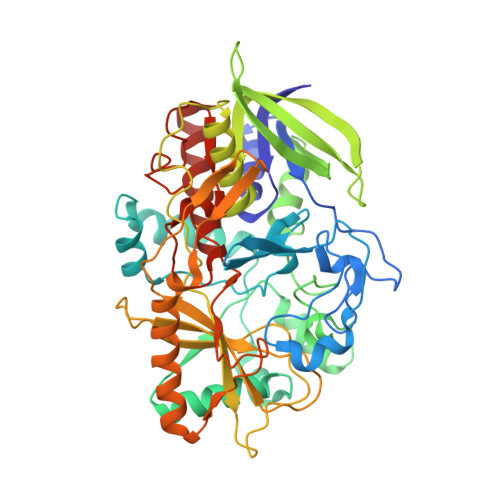A hydrogen-bonding network is important for oxidation and isomerization in the reaction catalyzed by cholesterol oxidase.
Lyubimov, A.Y., Chen, L., Sampson, N.S., Vrielink, A.(2009) Acta Crystallogr D Biol Crystallogr 65: 1222-1231
- PubMed: 19923719
- DOI: https://doi.org/10.1107/S0907444909037421
- Primary Citation of Related Structures:
3GYI, 3GYJ - PubMed Abstract:
Cholesterol oxidase is a flavoenzyme that catalyzes the oxidation and isomerization of 3beta-hydroxysteroids. Structural and mutagenesis studies have shown that Asn485 plays a key role in substrate oxidation. The side chain makes an NH...pi interaction with the reduced form of the flavin cofactor. A N485D mutant was constructed to further test the role of the amide group in catalysis. The mutation resulted in a 1800-fold drop in the overall k(cat). Atomic resolution structures were determined for both the N485L and N485D mutants. The structure of the N485D mutant enzyme (at 1.0 A resolution) reveals significant perturbations in the active site. As predicted, Asp485 is oriented away from the flavin moiety, such that any stabilizing interaction with the reduced flavin is abolished. Met122 and Glu361 form unusual hydrogen bonds to the functional group of Asp485 and are displaced from the positions they occupy in the wild-type active site. The overall effect is to disrupt the stabilization of the reduced FAD cofactor during catalysis. Furthermore, a narrow transient channel that is shown to form when the wild-type Asn485 forms the NH...pi interaction with FAD and that has been proposed to function as an access route of molecular oxygen, is not observed in either of the mutant structures, suggesting that the dynamics of the active site are altered.
Organizational Affiliation:
Department of Molecular, Cell and Developmental Biology, University of California, Santa Cruz, Sinsheimer Laboratories, Santa Cruz, CA 95064, USA.
















